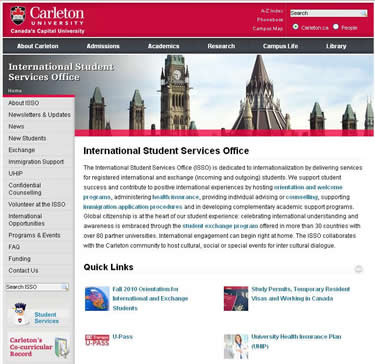Love Your Links: Google Analytics Link Optimization
As first revealed in a past blog post, optimizing links on your web site is another method that can help increase your site’s ranking in search engine ranking pages (SERPs). This week’s blog will explore this topic further and provide tips on how you can maximize link optimization by embedding links within your site content and establishing backlinks from other external sites.

So some may be asking why links are such a big deal and how can something so small help increase visitor traffic to my web site. Most Carleton sites already do a fairly good job of embedding internal hyperlinks to other sections of their own web site within the body of their text. The Quick Links feature on CCMS pages is also a good way to highlight specific sections of your site to visitors on your home page.
In addition to internal linking, one of the most important SEO tactics according to SEO gurus is optimizing backlinks to your web site. Backlinks, also known as incoming links or inbound links, are links directing visitor traffic to your site from an external web site or page. It is believed that the number of backlinks to your web site is an indication of the popularity of your site so web site administrators often go through a lot of trouble to maximize their backlink numbers often leading to unethical web practices that do their site more harm than good. For example, link broker companies offer inbound link-building services that claim will boost your search engine ranking but that is actually is a form of link spam. Also, some sites will engage in link farming which is a group of sites that all hyperlink to every other site in the group.
Here are some best practice tips to help you optimize your links.
- Use keywords in your link anchor text. When linking to pages within your own site, use keywords or descriptive text as the text link. For example, if the link will take the visitor to a page with information about the Graduate program, the text link should say “Graduate Program Information” instead of “Click here”. The same practice should be used for backlinks directing traffic to your site. Other generic anchor text to avoid is “page” or “article”.
- Obtain quality backlinks. One of the key link SEO tactics to help move your pages up in the SERPs is inviting other web sites to link to your content. The best external links to your site are those created by your readers on their blogs and various social networks, as they’re the most trusted and also generate a lot of direct traffic. It’s best if you get links to your site that are embedded in an article that is relevant about your site as search engines consider them more relevant because they look more natural (like a person links to your article on your site in their post because they like it). Tweet your posts and if they catch other tweeters’ interest, they will want to retweet them. Remember though, if you practice reciprocal linking you may find your site penalized for link farming.
- Update links regularly. If your links direct users to timely content, such as news or event posts, ensure that these links are kept up-to-date. For example, if you are promoting your department’s speaker series and the keyword Speaker Series is linked to a specific event that occurred in 2009 when you first wrote the content, you must update this link to direct it to the most recent speaker series. Ideally, unless you want to be regularly re-directing this link, target your links to a standing URL, or a page that contains static content which may be your news or events home page or a link to your Speaker Series category listing.
- Link to internal pages located deep within your site. Many web sites focus on creating links to their home and top-landing pages, however, directing traffic to harder to find content located deep within your site’s navigation is also beneficial to SEO. Deep internal and external linking provides a more diverse link portfolio as links pointing to deeper, specific content will lend to a greater variety of keywords and attract a wider audience to your site.
- Avoid broken links. Broken links reduce the credibility of your site and are a traffic killer. Avoid them like the plague! If you retire or change page URLs, make sure all links pointing to that URL are updated. Many Carleton pages contain links to external pages and when these external pages are updated it causes broken links. It’s good web practice to regularly check these external links to ensure they are pointing visitors to the intended content.
- Avoid duplicate content. Never duplicate news or events articles under different directories (or multiple URLs) on your site hoping that they will have more hits in doing so. Search engines such as Google penalize sites for this practice. As previously mentioned, it’s best to direct links to a standing URL.
Given that linking is such a crucial SEO builder, an upcoming Web Services initiative involves outfitting the Carleton.ca site with role-based home pages (top-level pages such as Students, Faculty, and Staff) where published news, events, and blog post links will be displayed on one of these pages based on their relevance to visitors of that page. This will enable Carleton sites to have greater visibility and accessibility across the Carleton web community. The emphasis on establishing good linking practices on your web site is extremely important as it impacts the entire Carleton web community. Happy linking!